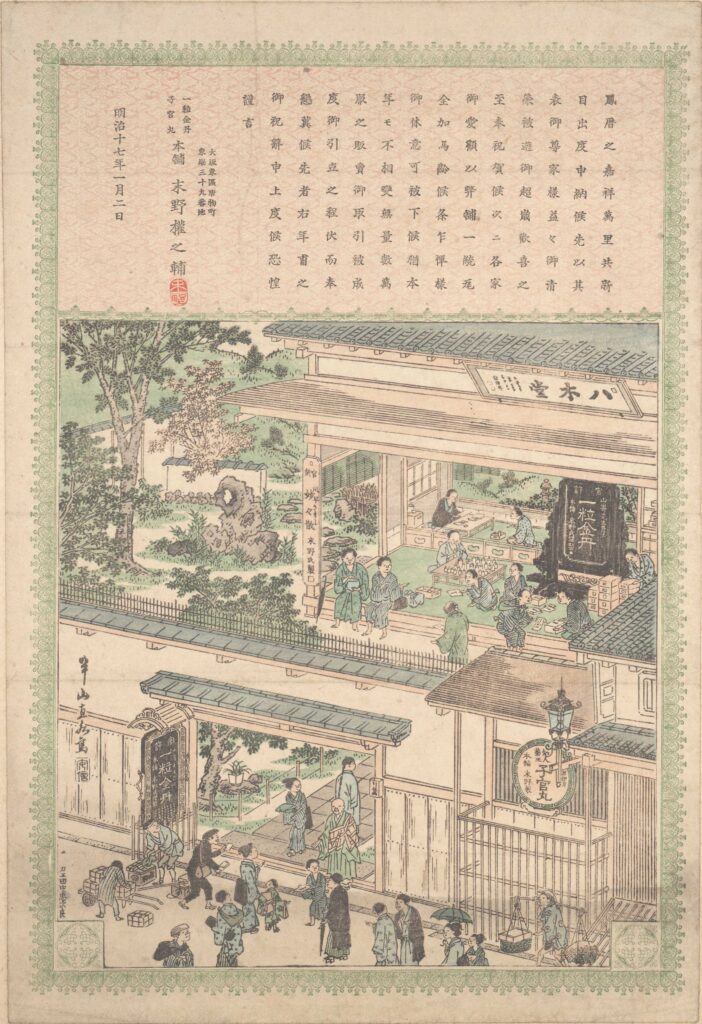In January of 2013 the Archives staff installed a new exhibit titled “Pharmacy and Pharmacists” in the first floor gallery of the Library that will be on display through the end of the year.
This exhibit presents a selection of Japanese prints portraying traditional drug compounding and distribution establishments. Numerous advertisements for drug stores carefully depict pre-modern shops which were open to the street and had several signs promoting proprietary medicine and other store specialties. On many prints the physician (identifiable by his bald head) can be seen consulting with the pharmacists. Around the store, assistants and apprentices are preparing herbal drugs by grinding and powdering medicinal plants, dispensing drugs to customers and delivering new shipments of herbs. Some streets in Tokyo and other cities had rows of wholesale and retail drug emporia boldly advertising their traditional and Western-style products. The artists also show people from different walks of life in the street scenes where drugstores serve as a backdrop for everyday activities, with two prints depicting views of Mt. Fuji.

Yagi Hall (Yagidō), 1884
Artist: Matsukawa Hanzan (Japanese, 1818-1882)
Woodblock print; ink and color on paper
37.7 x 25.5 cm
Object ID: ucsf_p279
A Japanese print with Chinese writing depicting a large drug wholesale business in Osaka by the name of “Yagido.” The business specializes in imported traditional Chinese medicine and seems to be appealing to preferred customers via this advertisement.
More information about this image: http://bit.ly/ucsfp279
In the scene on the handscroll, the artist portrayed the famine of the Tenpō era, with starving victims receiving medicine in a Kyoto drugstore.
The two hanging scrolls were most likely painted by Yoshimasu Nangai. One is a portrait of his father, renowned physician Yoshimasu Tōdō. The other refers to Tōdō’s theory that all illnesses are caused by a single “poison.”
About the Collection
The prints displayed in this gallery are selections from the UCSF Japanese Woodblock Print Collection, a component of the Library’s East Asian Collection. In 1963 UCSF Provost and University Librarian, later Chancellor, John B. de C. Saunders, M.D., started the East Asian Collection which was then developed over the next thirty years by Librarian/Curator Atsumi Minami.
The prints and scrolls were purchased from various smaller collections in Japan. Throughout the collection of more than 400 prints are some outstanding examples of ukiyo-e, a Japanese art form that flourished from the late 17th to mid-19th centuries.
The majority of the prints focus on health-related themes: the introduction of diseases such as measles and smallpox, drug advertisements, women’s health, pediatrics, and the influence of European traders on Japanese health and medicine. The intersection of health and religion is a theme that permeates the collection. Many of the prints depict Shinto or Buddhist deities intervening to prevent disease, or use Confucian or Buddhist imagery to communicate a message about health or nutrition.
The UCSF Japanese Woodblock Print Collection may be viewed online at http://asian.library.ucsf.edu/. Visitors to the website may search for prints by keyword or artist, view prints by theme, and read essays about prominent themes in the collection (including drug advertisements).
Cards, t-shirts, and coffee mugs featuring images of selected prints are available for purchase at http://www.zazzle.com/ucsflibrary.